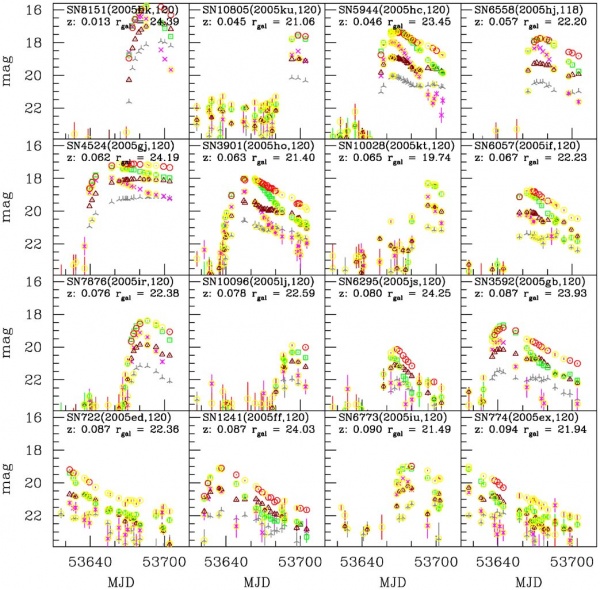Triggers:Supernovae
Supernova Types and Rates
Numbers based on Belokurov and Evans (1993: MNRAS, 341, 569-576). Note that f in the table below is the fraction of all type-II supernovae that are L-type. The numbers are derived by taking the Galaxy number counts out to 75 Mpc and extrapolating as D^3. These are combined with supernova event rates compiled from the literature.
Although Belokuroav and Evans used an old scanning law to make their predictions, the numbers of total events down to G=20 will not change.
This magnitude limit corresponds to a distance of 630 Mpc for a type-Ia with an average G-band maximum magnitude of -18.99.
| Type | Total to G=20 |
|---|---|
| Ia | 48000 |
| Ib | 7000 |
| IIL | 5600*f |
| IIP | 28500*(1-f) |
The other piece of information needed is the Luminosity function. Supernova absolute magnitude distributions are also given in Belokurov and Evans. They
assume Gaussian distributions of absolute magnitude around maximum brightness as below:
| Type | M\dG\u | sigma\dG\u |
|---|---|---|
| 1a | -18.99 | 0.76 |
| 1b/c | -17.75 | 1.29 |
| II-L | -17.63 | 0.88 |
| II-P | -16.44 | 1.23 |
Supernovae type Ia
SDSS-II Supernova Survey (Stripe 82)
Stripe 82 spreads over 300 sq.deg between RA=-60 to RA=60 and Dec=-1.25 to Dec=+1.25. It was monitored by SDSS in 5 filters (ugriz) since 1998, but more intensively in 2005 and 2006. Numerous supernovae were found in 2005 season using difference imaging techniques, e.g. Sako et al. 2008.
 From Holtzman et al. 2008.
From Holtzman et al. 2008.
Supernovae type II
Luminous Red Novae
The class of Luminous Red Novae was established in 2007 by Shrinivas Kulkarni classifying M85 OT2006-1 as LRN. It is disputed if it is a new class or subclass of SN-IIp.
- they are fainter than SNe and brighter than novae.
- they last over several weeks.
- distinctively red in colour, getting redder while fading